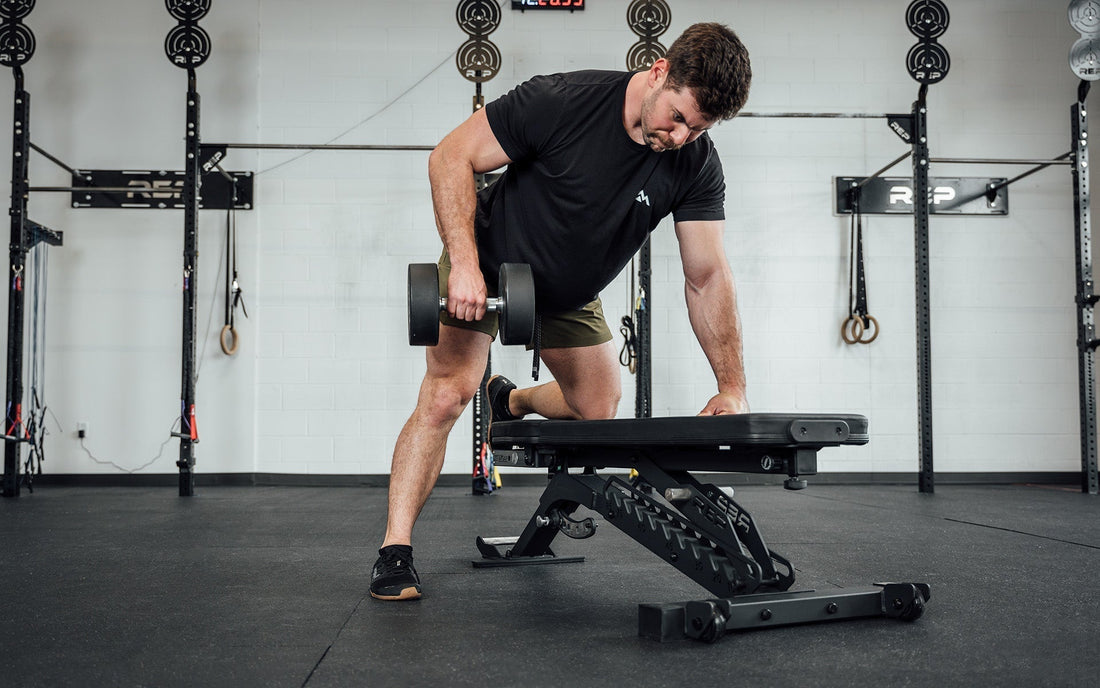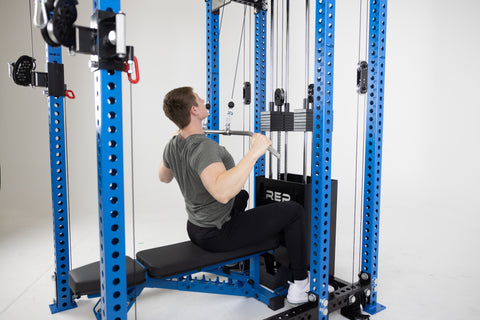
Pull-ups are often crowned the most popular—and equally the most challenging—back exercise, whether you're aiming to build strength and power in your back, achieve the aesthetics of a well-defined v-taper, or a bit of both.
Whether you’re a bodybuilder, functional fitness athlete, strength athlete, or just enjoy working out for health, your back is one of the most important pieces that makes up the puzzle that is you, and we can look to the pull-up bar to build it.
But what if you don't have a pull-up bar? What if you cannot do pull-ups (yet)?
Here are a few alternatives to pull-ups you can implement either instead of or in addition to pull-ups.
Which Muscles are you Working Out When Doing Pull-ups?

To find the best pull-up alternatives, let’s first understand what targets we’re aiming to hit.
- The lats: Your latissimus dorsi, commonly referred to as “the lats,” is your upper back’s main character. It takes up the majority of the back’s mass, responsible for the width of your body. It connects under your arm and ranges from your mid to low back.
- The traps: The lower portion of your trapezius, or “traps,” are the muscles running the center of your upper back like columns on either side of your spine.
- Your biceps: Your biceps brachii, or simply your biceps, your peaks, or as many of us have come to affectionately call them, “the gun show,” are the longer muscles of the upper arm responsible for pulling.
- Rear delts and forearms: Pull-ups also use some secondary muscles, such as your rear delts, which pull your shoulders back, and the intricate muscles in your forearms, which are responsible for grip, pronation, and articulation of the wrist and hand. Forearms are the unsung heroes of pulling exercises, because if you can’t hang on to a bar, it’s difficult to work out with it.
Pull-ups will build your back in different ways, depending on where you place your hands on the bar. It is a simple difference but important to understand. The narrower your hand placement during a pull-up, the more focus will be placed on the center of your back, working more of your lower traps and building you thicker. The wider your hand placement, the more focus will be placed on the width of your back, working more of your lats.
Love the benefits but looking for pull-up alternatives? Here are six variations to try instead of pull-ups.
1. Chin-ups and Pull-up Variations

Chin-ups are a great exercise to help in the development of pull-ups or to shift from your lats to a more biceps-focused exercise.
How to Do a Chin-up
- To do a chin-up, grab the bar underhand and pull yourself up until the bar is under your chin.
- Exhale on your way up.
- Throughout the motion, both up and down, squeeze your lats and lower traps, pinching your shoulder blades, and flexing your biceps throughout.
- Chin-ups will work both your back muscles and your biceps, but by switching from the traditional wide grip of a pull-up, it puts more emphasis on your biceps.
Learn more about the different hand positions on the pull up bar and the muscle groups they target here.
2. How to Do Assisted Pull-ups

Arguably the simplest pull-up alternative is the assisted pull-up machine. This piece of equipment is monumental in helping people who can't achieve a full pull-up develop the strength in their backs and arms until they can.
By setting the appropriate counterweight on the assisted pull-up machine, you can customize how challenging to make each individual set. Once the weight is selected, step or kneel on the weight assist, grab hold of the pull-up bar and perform the exercise just as you would on a normal bar.
If you don’t have access to an assisted pull-up machine, you can easily create your own version using pull-up bands (resistance bands) looped around a pull-up bar. Pull-up bands provide the assistance you need to build strength progressively and are a great alternative for home or gym setups without machines.
How To Do Assisted Pull-ups With Bands:
- Loop a resistance band over the pull-up bar, making sure it's securely fastened.
- Step one foot into the lower loop of the band, keeping your other foot free or resting on the band for additional stability.
- Grab the pull-up bar with both hands, palms facing forward (or in your preferred grip), and pull yourself up just as you would during a regular pull-up.
- The band will reduce some of the load by assisting you at the bottom of the movement, allowing you to work through the full range of motion while building strength. As you get stronger, you can switch to lighter bands for less assistance until you can perform unassisted pull-ups.
3. Seated Suspension Pull-Ups
Suspension Training ™ is a fantastic way to progress your pull-ups. Here's one of my favorite variations.
How to do Seated Suspension Pull-Ups
- Anchor a set of TRX® Suspension Trainer™ straps or Competition Gymnastic Straps and Wood Rings to an overhead anchor point, such as a pull-up bar or gym rack.
- With handles directly overhead, take a seat on the floor. The strap length should have the handles resting slightly above shoulder height. Grab hold and pull your shoulders back and down.
- Take a breath, brace your core and pull yourself up off the floor. You can control the difficulty level by using your feet to provide support. Do your best not to rely on the legs for help and to keep the work in the upper body.
- Lower back down and repeat for desired number of reps.
- Pro tip: For the most advanced level of this movement, extend your legs out in front of you so you're sitting in an L position on the floor. When you lift into the pull-up, keep your legs extended, hovering just above the ground. This should provide extra core activation and tension on the upper body.
4. Pull-Up Alternative: Australian Pull-ups
This pull-up variation gets its name from doing pull-ups “down under” a bar.
How To Do Australian Pull-Ups:
- Lie beneath a bar (you can use a barbell resting on pin-pipe safeties or gymnastics rings), keeping your feet on the ground.
- Pull your chest to the bar.
- Depending on how high you set the point of your hands, Australian pull-ups can work as a sliding scale between traditional pull-ups and rows. The higher the bar, the closer the exercise imitates pull-ups. The lower the bar, and the more level to the ground you remain, the more the exercise imitates rows.
- Once again, wider hands equals more lats, and narrower grip equals more traps.
5. Pull-Up Alternative: Lat Pulldown Machines

Lat pulldowns are essentially the same movement as pull-ups, but with nuanced differences, i.e., lacking the stabilization from the weight of an entire body. They play a powerful role in developing the same muscles and movement while providing the option of weight below and above bodyweight. Additionally, there are many variations of pulldowns themselves, including wide-grip, narrow-grip, one-arm, and underhand.
How to do a lat pulldown:
- Set the knee pad to a secure height to hold your body in place.
- Then choose your weight.
- Grab the bar (wide for width, narrow for thickness).
- Pull the bar down to the top of your chest while squeezing your shoulder blades together.
- Exhale on the way down.
- Lastly, raise the bar to a full extension with control. That there’s one rep!
By doing one-arm alternations, strength imbalances can be evened, and by doing underhand pulldowns, you mimic the benefits of a chin-up.
Learn More About Lat Pulldowns:
Benefits of Close-Grip Cable Lat Pulldowns
Is This the Single Best Attachment for a Power Rack?
6. Pull-Up Alternative: Bent-Over Rows

Another popular back exercise, bent-over rows can be performed in multiple ways. Whether with barbells, dumbbells (simultaneous or alternating), an Open Trap Bar, or resistance bands, bent-over rows are a staple of building a strong and defined back.
The most important thing to remember during this exercise is to choose a weight that your spine can support. Whether you are going for one rep or a thousand, don’t let your back bow. Maintain control of your posture, and therefore, your safety.
How to do a bent-over barbell row:
- Bend over while maintaining a straight spine.
- Arch your hips back.
- Bend your knees a little.
- Be sure to keep your weight in your heels rather than slipping forward into your toes.
- Next, take hold of your weight, and while maintaining your straight back, pull the bar or band to your chest, making sure to squeeze your shoulder blades together at the top of the lift.
- Exhale on the way up.
- When lowering weight, maintain control through the full extension.
- Wash, rinse, and repeat.
7. Pull-Up Alternative: Seated Cable Rows

Seated cable rows are quite similar to bent-over rows, but with seated stability, there is less strain on your lower back and hips. To properly perform the exercise, repeat the form of a bent-over row from a seated position.
Tips for Seated Rows
In addition to protecting your spine and not bowing your back:
- Don’t rock back and forth with the motion, but maintain control of your upright, seated position.
- Pull the bar toward your torso until it reaches your midsection or just below your chest, around the level of your sternum. The exact position can vary slightly depending on your individual anatomy and the grip you're using, but the goal is to squeeze your shoulder blades together as you pull, keeping your chest up and your back straight.
- Avoid pulling the bar too high toward your neck or too low toward your stomach, as this can shift focus away from your back muscles or strain your shoulders.
Learn more about how to do a seated cable low row here.
Are Pull-ups Required for an Effective Back Workout?
In short, no, you do not need pull-ups to get a good workout for your back and biceps. No single exercise will ever break your workout by its absence.
However, pull-ups are incredibly effective, as are the different pull-up alternatives. By themselves, each exercise is beneficial, but paired in a cohesive workout plan, they complement each other to help you build a big and strong back.

NEWSLETTER SIGNUP
Product launch information, promotions, blogs, and REP news.







